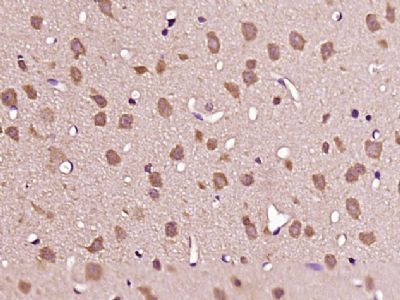产品货号 : mlR20303
英文名称 : HAP1
中文名称 : 舞蹈症相关蛋白1抗体
别 名 : Huntingtin Associated Protein 1; HAP 1; HAP 2; HAP-1; Hap1; HAP1_HUMAN; HAP2; HAPP; hHAP1; hHLP1; HIP 5; HIP5; HLP; HLP1; Huntingtin-associated protein 1; huntingtin-associated protein 2; Neuroan 1; Neuroan1.
研究领域 : 细胞生物 神经生物学 信号转导
抗体来源 : Rabbit
克隆类型 : Polyclonal
交叉反应 : Human, Mouse, Rat, Rabbit,
产品应用 : ELISA=1:500-1000 IHC-P=1:400-800 IHC-F=1:400-800 ICC=1:100-500 IF=1:100-500 (石蜡切片需做抗原修复)
not yet tested in other applications.
optimal dilutions/concentrations should be determined by the end user.
分 子 量 : 75kDa
细胞定位 : 细胞浆
性 状 : Lyophilized or Liquid
浓 度 : 1mg/ml
免 疫 原 : KLH conjugated synthetic peptide derived from human HAP1:551-650/671
亚 型 : IgG
纯化方法 : affinity purified by Protein A
储 存 液 : Preservative: 15mM Sodium Azide, Constituents: 1% BSA, 0.01M PBS, pH 7.4
保存条件 : Store at -20 °C for one year. Avoid repeated freeze/thaw cycles. The lyophilized antibody is stable at room temperature for at least one month and for greater than a year when kept at -20°C. When reconstituted in sterile pH 7.4 0.01M PBS or diluent of antibody the antibody is stable for at least two weeks at 2-4 °C.
PubMed : PubMed
产品介绍background:
Huntingtin-associated protein 1 binds to Huntingtin. Huntingtin is a protein that contains a polyglutamine region and when the number of glutamine repeats exceeds 35, the gene encodes a version of Huntingtin that leads to Huntington’s disease (HD). The ability of HAP1 to bind to Huntingtin is enhanced by an expanded polyglutamine repeat region. HAP1 shows neuronal localization and moves with Huntingtin in nerve fibers. HAP1 is primarily expressed in brain tissue, with greater expression in the olfactory bulb and brain stem. HAP1 in rat has been shown to associate with a number of intracellular organelles. Mouse HAP1 is localized to membrane-bound organelles including large endosomes, tubulovesicular structures and budding vesicles in neurons.
Function:
Associates specifically with huntingtin. This binding is enhanced by an expanded polyglutamine repeat.
Tissue Specificity:
Predominantly expressed in brain. Selectively expressed in neurons.
Similarity:
Contains 1 HAP1 N-terminal domain.
SWISS:
P54257
Gene ID:
9001
Important Note:
This product as supplied is intended for research use only, not for use in human, therapeutic or diagnostic applications.
产品图片












